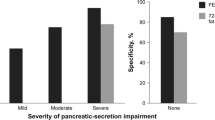Abstract
Background
This study aimed to prove that the urinary trypsinogen-2 dip stick test can be used for early diagnosis of pancreatitis after endoscopic retrograde cholangiopancreatography (ERCP).
Methods
For this prospective, blinded, pilot study, urine samples were collected before ERCP, 1 h after ERCP, and 4 h after ERCP. The urine dipstick test was used to detect trypsinogen-2 on the basis of immunochromatography. The dipstick results were compared with those of current methods used to diagnose post-ERCP pancreatitis. Once the patient disposition was finalized, pancreatic enzymes, clinical findings, and final diagnosis were obtained from the chart and compared with the urine trypsinogen-2 test findings. The sensitivity, specificity, and positive and negative predictive values were calculated.
Results
The urine trypsinogen dip stick test was performed for 30 patients (15 men and 15 women). Post-ERCP pancreatitis was diagnosed in 5 of 29 patients by clinician assessment, serum pancreatic enzyme levels, or both. The amylase and lipase levels for post-ERCP patients with and without pancreatitis were 650 ± 145 vs 134 ± 26 (p = 0.023) and 1,658 ± 594 vs 84 ± 17 (p = 0.057), respectively. This statement proves that patients who developed post ERCP pancreatitis had significant elevation of amylase and lipase compared to patients who did not have pancreatitis. For the dip stick test, 6 of 28 patients had positive results in 1 h and 6 of 29 patients had positive results in 4 h. The sensitivity of the 1-h test was 1.0, and the specificity was 0.91. The positive predictive value (PPV) was 0.66, and the negative predictive value (NPV) was 1.0. The sensitivity of the 4-h test was 1.0, and the specificity was 0.96. The PPV was 0.8, and NPV value was 1.0.
Conclusion
The urinary trypsinogen-2 dip stick test is useful for early diagnosis of post-ERCP pancreatitis and allows the testing physicians to begin management early in its course.

Similar content being viewed by others
References
Freeman ML, DiSario JA, Nelson DB, Fennerty MB, Lee JG, Bjorkman DJ, Overby CS, Aas J, Ryan ME, Bochna GS, Shaw MJ, Snady HW, Erickson RV, Moore JP, Roel JP (2001) Risk factors for post-ERCP pancreatitis: a prospective, multicenter study. Gastrointest Endosc 54: 425–434
Gottlieb K, Sherman S, Pezzi J, Esber E, Lehman GA (1996) Early recognition of post-ERCP pancreatitis by clinical assessment and serum pancreatic enzymes. Am J Gastroenterol 91: 1553–1557
Hedstorm J, Korvuo A, Kenkimaki P, Tikanoja S, Haapiainen R, Kivilaakso E, Stenman UH (1996) Urinary trypsinogen-2 test strip for acute pancreatitis. Lancet 347: 729–730
Hedstrom J, Sainio V, Kemppainen E (1996) Urine trypsinogen-2 as a marker of acute pancreatitis. Clin Chem 42: 685–690
Kemppainen EA, Hedstrom J, Puolakkainen P, Halttunen J, Sainio V, Haapiainen R, Kivilaakso E, Stenman UH (1997) Increased serum trypsinogen-2 and trypsin 2–alpha 1 antitrypsin complex values identify endoscopic retrograde cholangiopancreatography induced pancreatitis with high accuracy. Gut 41: 690–695
Kemppainen EA, Hedström J, Puolakkainen P, Halttunen J, Sainio V, Haapiainen R, Stenman UH (1997) Urinary trypsinogen-2 test strip in detecting ERCP-induced pancreatitis. Endoscopy 29: 247–251
Kemppainen EA, Hedström JI, Puolakkainen PA, Sainio VS, Haapiainen RK, Perhoniemi V, Osman S, Kivilaakso EO, Stenman UH (1997) Rapid measurement of urinary trypsinogen-2 as a screening test for acute pancreatitis. N Engl J Med 336: 1788–1793
Smotkin J, Tenner S (2002) Laboratory diagnostic tests in acute pancreatitis. J Clin Gastroenterol 34: 459–462
Sultan S, Baillie J (2002) What are the predictors of post-ERCP pancreatitis, and how useful are they? J Pancreatology 3: 188–194
Testoni PA (2002) Why the incidence of post-ERCP pancreatitis varies considerably? Factors affecting the diagnosis and the incidence of this complication. J Pancreatology 3: 195–201
Thomas PR, Sengupta S (2001) Prediction of pancreatitis following endoscopic retrograde cholangiopancreatography by the 4-h post procedure amylase level. J Gastroenterol Hepatol 16: 923
Author information
Authors and Affiliations
Corresponding author
Rights and permissions
About this article
Cite this article
Sankaralingam, S., Wesen, C., Barawi, M. et al. Use of the urinary trypsinogen-2 dip stick test in early diagnosis of pancreatitis after endoscopic retrograde cholangiopancreatography. Surg Endosc 21, 1312–1315 (2007). https://doi.org/10.1007/s00464-006-9099-2
Received:
Accepted:
Published:
Issue Date:
DOI: https://doi.org/10.1007/s00464-006-9099-2




